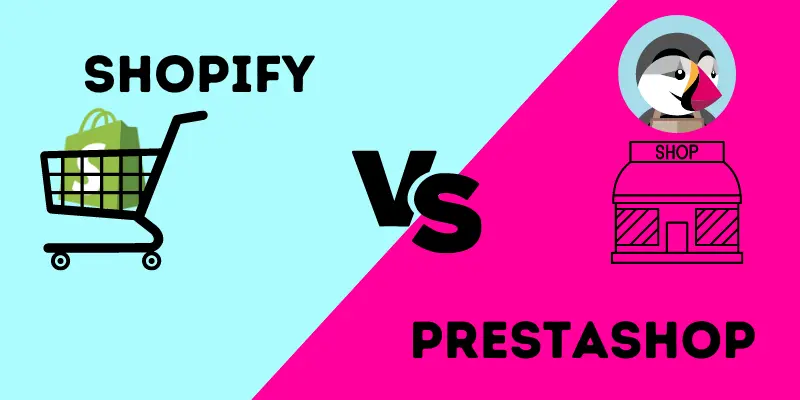
Shopify and Prestashop are online store builders with robust eCommerce features. Shopify is very well known among the top eCommerce building platforms. Prestashop is not much known among online sellers. Shopify and Prestashop provide the same functionality but their setup and management are different. Shopify includes built-in hosting which means that the security, maintenance, server problems, etc. will be managed by Shopify Whereas Prestashop needs to be self-hosted, It’s an open-source platform like WordPress and Magento.
#Quick Summary: Shopify vs Prestashop
Below are a quick summary of Shopify and Prestashop platforms.
Shopify
- Easy to setup & use
- Provides inbuilt hosting
- Over 100+ themes (9+ free themes) and pricing ranges from ($180 – $350)
- Shopify offers basic customization features
- Plenty of applications(6000+ apps)
- Excellent support & Resources
Prestashop
- Not easy to setup but it’s easy to use
- Open source free platform with no hosting
- Over 2000+ paid themes and pricing ranging from ($80 – $280)
- Prestashop is a developer-friendly platform that offers great customization
- Plenty of extensions (4000+ extensions)
- Doesn’t provide good support
#7 Main Differences : Shopify vs Prestashop
1. Ease of Use
Prestashop needs to be set up manually. it’s easy to use but requires good technical skills to manage the store, whereas Shopify is easy to set up, use, and manage.
Winner: Shopify
2. Pricing
Shopify’s plan Pricing ranges from $29 – $299 & includes additional pricing in form of apps & fees. Whereas Prestashop is a free platform but includes plenty of additional costs in form of apps, and themes.
Winner: Prestashop
3. Themes & Editor
Shopify offers 9 free themes and 80+ paid themes with a limited customization feature. Whereas Prestashop offers over 2000+ paid themes with excellent customization features.
Winner: Prestashop
4. Small businesses:
Shopify is easy to use and a ready-made platform that offers plenty of inbuilt features & apps whereas Prestashop isn’t easy to set up and also there is plenty of manual work to be done.
Winner: Shopify
5. Domain & Hosting:
Shopify has good hosting with a fast server & provides a custom domain upon purchasing an annual plan whereas Prestashop doesn’t provide hosting & a domain.
Winner: Shopify
6. Payments and Charges
Both Shopify & Prestashop offers plenty of payment gateways. Shopify charges transaction fees if payment was made using a payment processor other than Shopify payments.
Winner: Prestashop
7. App store
Both of the platforms have an app store. Shopify offers over 6000+ apps whereas Prestashop has 4000+ apps but the installation process of these apps is not easy.
Winner: Shopify
Ease of use
| Shopify | Prestashop | |
| Inbuilt Hosting | ✔ | ❌ |
| Domain Provides | ✔ | ❌ |
| Storage & Bandwidth | Unlimited | ❌ |
Shopify’s website offers a 14-day trial before subscribing to their basic plan ($29), unlike Prestashop which is completely free.
Shopify websites are easier to set up, just sign up and you’re ready to go while Prestashop requires downloading, installing, and managing most of the things by yourself. Prestashop provides a download link with instructions for setup, which may take longer for beginners.
Shopify offers a setup guide and has provided access to all store functions and options on the right side of the dashboard. If you have any problems, you can reach out to the live chat support in the help center for quick assistance. Prestashop becomes easier to use once set up. it has divided the store into two panels: the front office and back office, with the front office providing access to the shop page and the back office providing administration to manage store operations. If you want to test Prestashop’s ease of use, you can visit their live demo page online.
Key takeaways: Shopify is an easier platform to set up and manage, and Prestashop is not easy to get started but it’s easy to use. So Shopify is a clear winner.
The winner of the Ease Of Use Feature: Shopify
Shopify: 1-0 :Prestashop
Pricing & Plans
| Shopify | Prestashop | |
| Trial period | 14 days | No trial period |
| Starting price | $29.9/mo | $2.95/mo (Bluehost) |
| eCommerce price | $29.9/mo – $299.9/mo | $9.95/mo (Bluehost e-commerce) |
| enterprise pricing | Custom Pricing | No enterprise plan |
Shopify offers three basic plans that cover hosting, SSL, and storage fees. Additionally, Shopify also has a Lite plan for selling products on existing websites, fairs, events, etc. This plan starts from $6/month.
Basic Shopify:$29/mo
Shopify:$79/mo
Advance Shopify: $299/mo
Shopify Pricing

Prestashop is a free open-source platform and does not charge sales commissions. However, unlike other platforms, it does not include hosting, SSL security, etc. A domain must be purchased separately which costs around $10 per year. Prestashop has partnered with hosting providers like 1&1 and SiteGround to offer hosting at a lower cost, with the level of hosting depending on the number of monthly visitors.

In addition to these basic plans, there may be additional costs for themes and apps. Shopify does offer free themes but if they don’t meet your needs then choose premium themes costing between $150-$300. Shopify also has a variety of apps that can add additional functionality to the store, with an average cost of $0-$20 per month, depending on the business needs.
Prestashop might insist you spend more on their platform by purchasing their premium themes ranging from $75 – $240/year. There are modules that can cost an average of $60 – $600/year.
Key takeaways: Apart from Shopify’s fixed plans & Prestashop hosting prices Both platforms have complementary prices as themes & apps which are additional costs. These costs can vary by the business’s requirements hence it’s a tie.
The winner of the Pricing & Plans Feature: Tie
Shopify: 2-1 :Prestashop
Themes & Customization
| Shopify | Prestashop | |
| Themes | 80+ | 2000+ |
| Free Themes | 10+ | 0 |
| Mobile-Friendly | Yes | Yes |
| Theme Customization level | Basic | Very Good |
| Prebuilt Sections | No | No |
Shopify offers a wide variety of themes, with only 9 of them being free and the rest are paid with prices ranging from $100-$300. Prestashop, on the other hand, offers 20 times more themes than Shopify, with over 2000 themes in its library, which are paid and priced from $80-$279. Both Prestashop and Shopify provide detailed information about their themes, features, and support options.
Shopify themes

Prestashop themes

Both Shopify and Prestashop have a theme editor that includes blocks that can be easily inserted. The themes can be designed with various styles, colors, etc. Shopify has a theme code editor that allows editing with custom HTML, CSS, and Liquid code, but has limitations on checkout and cart customizations. Prestashop offers advanced customization but requires a good understanding of coding languages, and may require a developer’s assistance. The Prestashop theme can be downloaded, edited, and then re-uploaded to the platform.
Shopify editor
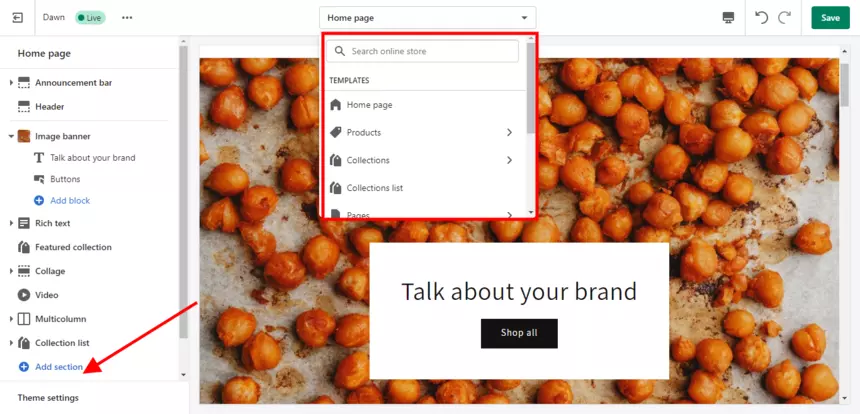
Prestashop editor

Prestashop advance customization

Key Takeaways: Prestashop has more themes and also it’s an open source where theme code can be accessed and can be customized as per the requirement.
The winner of the Themes & Customization Feature: Prestashop
Shopify: 2-2 :Prestashop
eCommerce Features
| Ecom Features | Shopify | Prestashop |
| Products | 1. Sell physical products & services. 2. Sell digital products through Shopify’s app digital downloads(free) 3. Import/export products(unlimited) 4. upload images & videos | 1. Sell physical & digital products. 2.Upload images.(videos are not allowed) 3. App Recommendation( Presto shop recommends apps as per the requirement) |
| Inventory | 1. Create tags, categories/subcategories 2. access product options(radio, swatches, button) from Shopify apps 3. Plenty of product attributes & up to 100 product variants. 4. domestic/international tax setting. | 1. Create categories, Assign brands 2. Add related products 3. Create multiple variants 4. Product availability labels, multiple tax setting |
| Payment options | Shopify provided various payment methods (nearly 100) which consist of popular payment providers PayPal, stripe, square, etc. The integration of these payment providers with Shopify is smooth. Shopify also accepted cryptocurrency as a payment provider. There is Shopify’s own payment method called Shopify payments which is available in a few countries. | Prestashop offers over 150+ modules as forms of payments processors. These integrations are free(30+) but most of them are paid. The integrations of these modules need to be done manually. |
| Shipping Option | Shopify has very good features for shipping as they have provides various discounts from top logistics companies like FedEx, USPS, DHL, etc. These help in estimating the live carrier rates based on the weight, location, etc. You can also print from these carriers directly from the Shopify dashboard. | Prestashop too has good shipping options. There you can set up multiple carriers and their rates. These carriers can be set up by weight, tax rate, location, etc. Prestashop recommends many shipping modules to add new features. |
| Fees | Shopify charges transaction fees of 2%-1%-0.5% on consecutive plans. These charges will apply if you use payment gateways other than Shopify payments to receive payments. The Credit card fees will still apply which depends on the payment providers. | Prestashop doesn’t charge any sale transaction fees. The credit card fees will still apply which depends on the payment processors. |
| POS | Shopify provides two POS plans POS lite & POS Pro. POS lite is free and comes with all plans Where as POS PRO costs($89/month). There is POS hardware which is provided by Shopify. | Prestashop has offered a POS system in its modules. |
Key Takeaways: Shopify and Prestashop both have ticked the boxes for basic e-commerce features but Shopify provides them as built-in features whereas in Prestashop most of these features have to be fetched from Modules.
The winner of the eCommerce Feature: Prestashop
Shopify: 2-3 :Prestashop
Marketing
| Features | Shopify | Prestashop |
| Email Campaigns | Shopify app store has plenty of email marketing tools. You will find email tools to run all kinds of campaigns. These tools’ integration is smooth with Shopify. There are free as well as paid tools like Klaviyo, Mailchimp, Privy, One, etc. | Prestashop doesn’t have an inbuilt email marketing tool. They have plenty of module integrations like MailChimp, Sendinblue, etc. To help in integrating with the tool. |
| Multichannel selling | In the left dashboard, there is an option for sales channels which includes Facebook, Instagram, google, amazon, eBay, etc. Where Shopify products can be synced and sold. | Prestashop also allows selling on the platforms like Facebook, Instagram Amazon, google, etc. |
| Social Media | In the marketing, section, Shopify has listed various social media campaigns which can be performed and managed directly from Shopify. There are various third-party apps to facilitate interaction with social media. | Prestashop has provided integration with Facebook to run and manage ad campaigns from PrestaShop. There are plenty of social media modules provided by Prestashop |
| Multilingual & MultiCurrency | If you are Shopify payments users you can avail of the multicurrency option, or else you need to use a third-party app. The multilingual option lets you upload multiple languages. | In Prestashop, the multilingual option is available in 65 languages. The localization option enables multicurrency conversion. |
| Apps | Shopify has over 6000+ apps in various categories, they are either free or paid. The apps will be billed monthly. | Prestashop has 4000+ modules in their marketplaces these are billed annually. |
Key Takeaways:- Both Shopify & Prestashop has inbuilt marketing features & also third-party apps. Shopify might provide easier integration & management of these apps as compared to Prestashop hence Shopify is the winner.
The winner of the Marketing Feature: Shopify
Shopify: 3-3 :Prestashop
SEO & Blogging
Both Prestashop and Shopify have good SEO features. They allow the optimization of titles, descriptions, URLs, images, etc. Users can access sitemaps and robots.txt files from both platforms. If users have difficulty managing these technical SEO settings, they can install apps provided by both platforms. Both platforms offer plenty of third-party SEO tools to auto-optimize, audit, and solve SEO issues.
Shopify has an inbuilt blogging tool while Prestashop users have to be accessed it through external modules. The blogging tool in Shopify allows writing about products, collections, etc, and has features such as assigning tags and categories and modifying comment settings.
Key Takeaways:- Shopify offers better SEO features and also has a built-in blogging section so it’s a winner.
The winner of the SEO & Blogging Feature: Shopify
Shopify: 4-3 :Prestashop
Analytics & Reports
The Analysis & reports of daily visitors and their activity are important in making data-driven decisions.
Both Shopify and Prestashop offer easy-to-use dashboards with useful metrics and visual representation of data. Shopify’s dashboard has a focus on graphical displays, while Prestashop provides more detailed information about sales, orders, visitors, and more. Both platforms can integrate with Google Analytics for deeper insights and reporting.
Prestashop dashboard
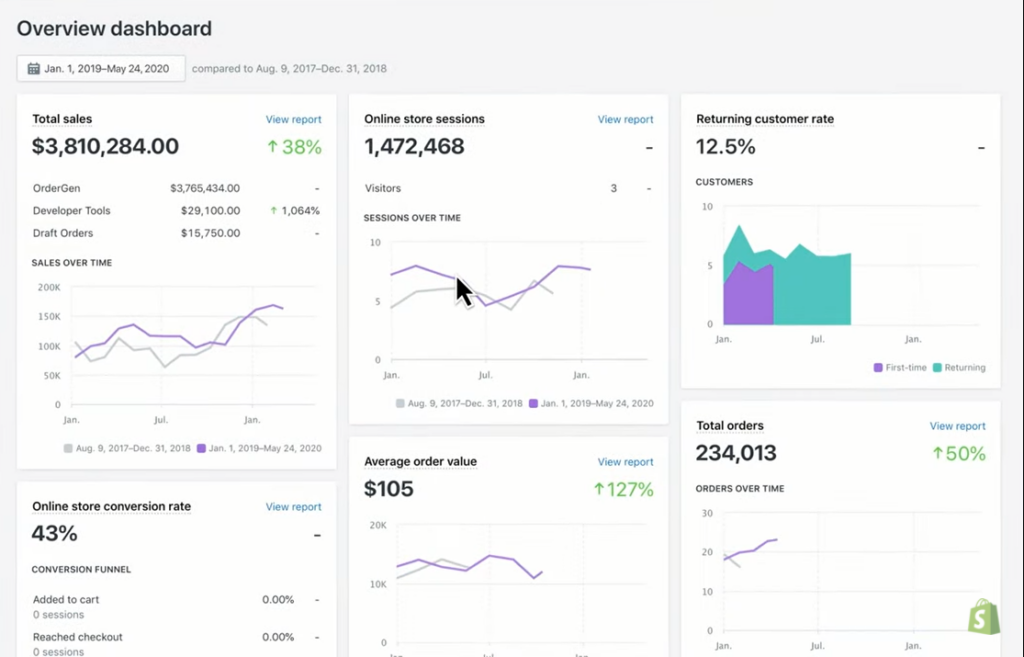
Prestashop dashboard

We have provided two screenshots for reference. Upon clicking view reports on Shopify display detailed data on customers’ spending time on the website, and devices used to visit. There are built-in reports that provide detail on sales by country, sales by region, sales by acquisition, sales by market, etc. As users upgrade to an advanced plan users can unlock more reports and also can build custom reports. Prestashop too provides some good reports In the left corner there is an option for stats that provide the detail on the best customers, best products, catalog statistics, Best vouchers, etc. These provide valuable insights for remarketing/acquiring customers for a long time. This will help in setting up the right marketing campaign over the provided data.
Shopify Analytics Example
Shopify’s live reporting is good as it allows tracking store visitors converting as customers from all across the world. This allows for setting up lots of campaigns for retaining customers in real-time itself.
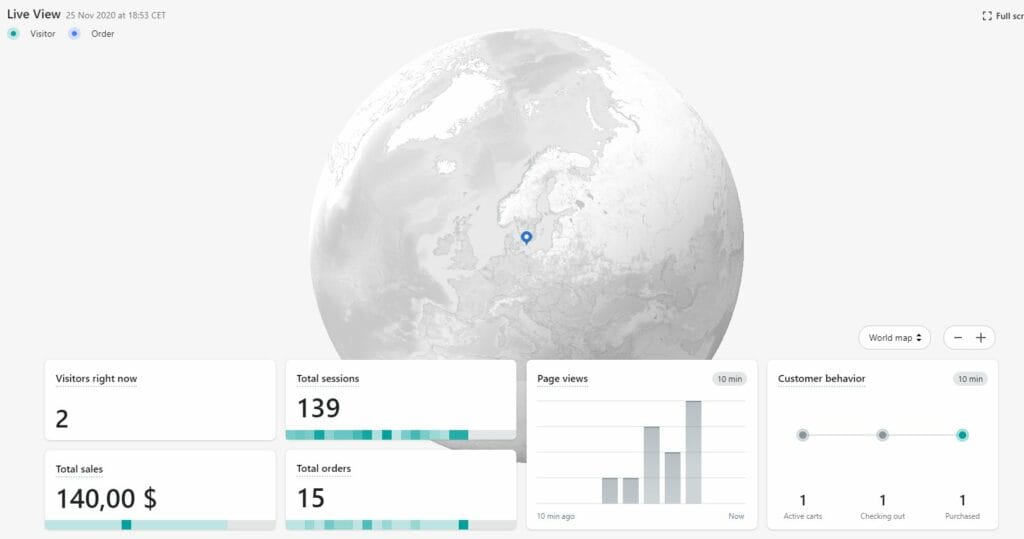
Prestashop stats

Key Takeaways:- Both shopify & PrestaShop have provided pretty good insights & graphical representation on their platform hence its tie.
The winner of the Analytics & Report Feature: Tie
Shopify: 5-4 :Prestashop
Support & Resources
| Shopify | Prestashop | |
| ✔ | ❌ | |
| Live chat | ✔ | ❌ |
| Phone | ✔ | ✔ |
Shopify offers excellent support for all plans even for those on a free trial. With 24/7 live chat, email, and phone support available. Prestashop, being an open-source platform with a steeper learning curve doesn’t have a support team. Their support plans need to be purchased from modules.
There are plenty of resources to seek help. it has an active community where fellow shopify members & support staff reply to queries. Though the Shopify learning curve is easy still providing all forms of support to the user is plus.
Shopify Support
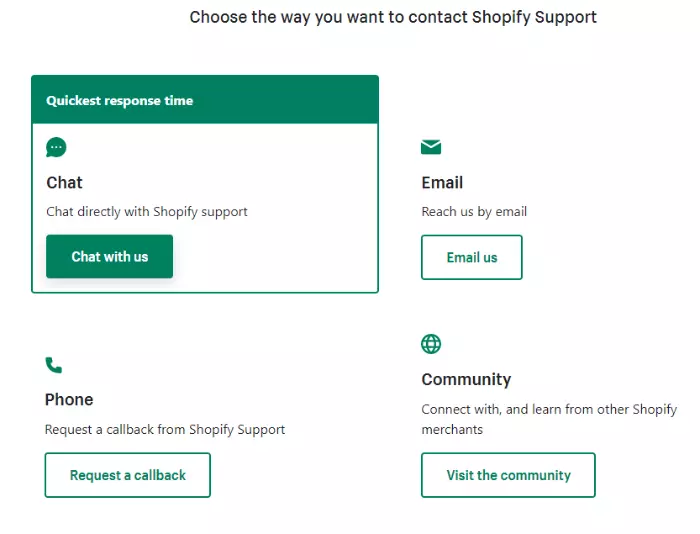
Prestashop support

prestashop support plans

Prestashop provides additional sources in the form of blogs, videos, and forums where you can get help.

Key Takeaways:- Shopify has provided better-dedicated support whereas for Prestashop we need to purchase plans hence Shopify is the winner.
The winner of the Support & Resources Feature: Shopify
Shopify: 6-4 :Prestashop
Pros and Cons: Shopify vs Prestashop
| Shopify Pros | Shopify Cons |
| 1. Easy to use & setup | 1. Transaction fees apply for using payments other than Shopify payments |
| 2. Shopify has 6000+ apps. | 2. Shopify has several limitations in theme customization |
| 3. Shopify has 24/7 support | 3. Shopify apps can be expensive. |
| Prestashop Pros | Prestashop Cons |
| 1. Open Source platform | 1. Not easy to setup |
| 2. The themes can be customized extensively | 2. Too much dependency on the modules & Paid themes |
| 3. Plenty of themes & Modules | 3. Prestashop can be expensive. |
Conclusion: Shopify vs Prestashop:
Use Shopify over Prestashop,
- If you want a platform that is easy to use and manage then Shopify is better.
Use Prestashop over Shopify,
- If you want a platform that offers greater customization with the theme then Prestashop is better.

Declan Kingston mainly works around strong Data to create powerful visuals, complex graphs to make the right decision for companies. He has been working in this field for over 8 years, has a strong knowledge of eCommerce platforms and website builders. He has worked with Ethereum and Looker Data Sciences, Inc. (now part of Google Cloud).



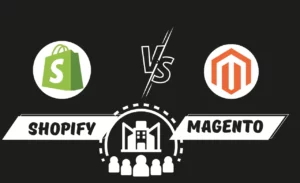

![How To Make A Website? 3 Different Ways Showed With Step By Step For Beginners. Choose The One You Liked [2024] How To Make A Website - 3 Different Ways](https://websitebuilderly.com/wp-content/uploads/How-To-Make-A-Website-3-Different-Ways-300x150.webp)



has provided access to all store functions and options on the right side of the dashboard. If you have any problems, you can reach out to the live chat support in the help center for quick assistance. Prestashop becomes easier to use once set up. it has divided the store into two panels: the front office and back office, with the front office providing access to the shop page and the back office providing administration to manage store operations. If you want to test Prestashop’s ease of use, you can visit their live demo page online.
https://livecargame.netlify.app/
Prestashop is not much known among online sellers. Shopify and Prestashop provide the same functionality but their setup and management are different. Shopify includes built-in hosting which means that the security, maintenance, server problems, etc. will be managed by Shopify Whereas Prestashop needs to be self-hosted, It’s an open-source platform like WordPress and Magento.
https://spacebarcounter.org/
As users upgrade to an advanced plan users can unlock more reports and also can build custom reports. Prestashop too provides some good reports In the left corner there is an option for stats that provide the detail on the best customers, best products, catalog statistics, Best vouchers, etc. These provide valuable insights for remarketing acquiring customers for a long time. This will help in setting up the right marketing campaign over the provided data.
https://monkey-type.net/